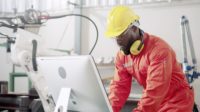Quality 101
How to Ensure Your Robots Operate Safely
As robotics use grows throughout processing, packaging, and logistics environments, it’s important to understand your options — and how to keep up with safety guidelines.

Image Source: gorodenkoff / iStock / Getty Images
As robots become more prevalent throughout a range of manufacturing industries, it’s more critical than ever to ensure their safe operation. Whether you’re using traditional industrial robots, collaborative robots (cobots), autonomous mobile robots (AMRs), or even humanoid robots, common safety features, challenges, and best practices are important to understand as you navigate the complexities of robotics.
Fixed Industrial Robots
Standard industrial robots are used in all manner of manufacturing, from heavy-duty car chassis welding to pill sorting for packaging applications. Articulated robots are by far the most common types seen in industrial applications. Much like human arms, their multiple rotary joints enable precise movement of heavy loads. It’s not uncommon for these robots to handle more than 1,000 kg. FANUC has a model with a payload of 2.3 tons — able to handle entire automotive chassis or foundry parts.
SCARA (selective compliance articulated robot arm) and delta robots typically handle considerably lighter loads and are well suited to pick-and-place and assembly tasks requiring high speed and accuracy. SCARA robots have a compact design, are easy to use, and require minimal maintenance. Delta robots — with multiple lightweight arms making them look like spiders — are usually faster than SCARA robots but are not as robust, with extremely light payloads.
Cartesian robots, also known as gantry robots, move in straight lines along three axes, enabling the highest level of precision while also enabling scaling to large sizes and heavy payloads.
Despite the wide range of payloads and applications they handle, what these industrial robots have in common from a safety perspective is that they all operate in controlled environments, often enclosed within safety cages or other physical barriers and interlocks that prevent human access during operation. Most robots are equipped with sensors that detect obstructions and emergency stop mechanisms that immediately halt operations if safety is compromised in any way.
Collaboration With Humans
Cobots, on the other hand, do not have to work in controlled environments. They are designed to work alongside human operators, enhancing flexibility and productivity in environments where tasks require human-robot collaboration (thus the name collaborative robots).
Cobots have intrinsic safety features that allow them to operate safely in close proximity to people. For example, cobots can detect contact with humans and then limit the force exerted during those interactions, reducing the risk of injury. Built-in sensors also control speed and motion, causing cobots to slow down or stop, for example, when a human worker comes near.
Although cobots do not require the kinds of controlled environments needed with standard robots, they nonetheless have their own safety protocols, including proper risk assessment and regular maintenance to ensure their safety features remain effective. Human-robot interaction can be complex. Ensuring that robots are designed to accommodate human factors and ergonomic considerations is vital to prevent accidents and improve the user experience.
Going mobile
Not all robots work in fixed locations, of course. Autonomous mobile robots have become increasingly common, particularly for transporting goods in logistics and warehousing. With advanced sensors and navigation systems — such as lidar and cameras — AMRs have the ability to work (of course) autonomously.
Those sensors have a lot to do with maintaining safety around AMRs. Sensors designed for obstacle detection and avoidance enable the robots to navigate around obstacles, reducing collision risks. Human interaction protocols also include warning signals and controlled navigation speeds to ensure that AMRs interact safety with human workers in shared spaces.
Standards and Revisions
To ensure the safe operation of all types of robots, compliance with standards is essential. Focused on the safety requirements for industrial robots and robot systems, ANSI/RIA R15.06 is a U.S. standard developed by the Association for Advancing Automation (A3) in conjunction with the American National Standards Institute (ANSI).
ISO 10218, which also provides guidelines and requirements for industrial robots, is an international standard developed by the International Organization for Standardization (ISO). Such standards ensure not only that robots are designed and built safely but that they are operated safely as well.
ANSI/RIA R15.06 is harmonized with ISO 10218, facilitating global compliance and ensuring that safety practices are consistent across different markets. The standards detail requirements in design and maintenance, risk assessment, protective measures, safety functions, and more. They also provide guidelines for robotic systems — including installation, integration, and interaction with other systems and humans.
ISO 10218 was originally published in 2012, with an update in 2016. With about 3.5 million systems in operation today, the use of industrial robots has almost doubled since that revision — driven by advances in robotics technology, increased automation in various industries, and growing adoption across different sectors.
The ISO 10218 standard is currently undergoing significant updates to address evolving technologies and safety needs. Although it’s been a considerable undertaking, the work is needed to ensure that the standard remains relevant as robots evolve. The revision includes:
- Enhanced risk assessment guidelines: The updated standard emphasizes more comprehensive risk assessment procedures that account for new robotic technologies and applications. This includes more detailed guidance on evaluating risks associated with advanced robotics systems and their interactions with humans.
- Integration of cobots: The revised standard incorporates specific requirements for cobots, addressing the unique safety considerations of human-robot collaboration. This includes clearer definitions of safety functions and operational parameters for cobots.
- Improved safety functions: Updates include more stringent requirements for safety functions, such as improved force and speed limitations for robots interacting with humans. These changes aim to enhance the effectiveness of safety features and reduce the risk of accidents.
- Cybersecurity considerations: The new standard introduces guidelines for addressing cybersecurity risks associated with robotic systems. As robots become more connected and integrated into digital networks, protecting against cyber threats is increasingly important.
Best Practices for Implementing Robotics Safely
It’s a well-known axiom that the most dangerous piece of equipment on the factory floor is the one that’s not working. With pressure to get production up and running again, employees too often try to bypass the safety mechanisms in place to get a system back online. To avoid this situation and to keep your robotic systems running safely, regular maintenance is key. Implement a routine maintenance schedule to ensure that safety features and mechanisms are functioning correctly. Regular inspections help identify and address potential issues before they result in accidents.
Training and certification are important as well. Ensure that operators and maintenance personnel are thoroughly trained and certified in robot operation and safety protocols. Regular refresher courses can help maintain high safety standards.
The future of robotics safety will likely see advancements driven by emerging technologies and evolving standards. Innovations in artificial intelligence, machine learning, and sensor technologies will enhance robots’ ability to operate safely in complex environments. New safety standards and regulations will continue to shape the development and deployment of robotic systems.
For more on getting started with robotics, check out the beginner’s guide from A3 at www.automate.org/robotics/beginners-guide.
Looking for a reprint of this article?
From high-res PDFs to custom plaques, order your copy today!





